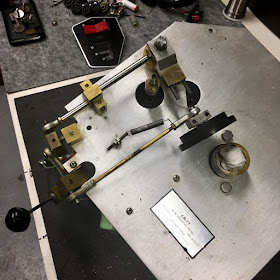It is with great sadness that I learned of Art Dudley's demise. I was very honored when he gave me credit on the Altec 755C/Open Baffle article he wrote for Stereophile many years ago. Even if we never had the chance to meet, we had exchanged a few emails and private messages. Aside from being an audio and music lover, Art was a true gentleman!
From one idler turntable enthusiast to another, here's to you Art!🍻
My first exposure to this "stick-shift" controlled turntable was back in the late 90s when Ding scored a Gates CB77 at a Hamfest for next to nothing. These broadcast units were still under the radar then and I was confident that I'd be just as lucky. But as time passed, I had to resort to the auction site to add one to my collection.
 |
| Drive train sub-chassis built on 1/8" aluminum plate |
Aside from the motor mounts which were showing signs of aging, my unit was mechanically sound.
Replacing the motor mounts
 |
| fresh rubber mounts installed from McMaster-Carr |
My idler wheel was in excellent condition but it's always good to have a spare. I ordered an idler from Serge at Karmadon. Highly recommended!
 |
| L = original idler, R = Karmadon idler |
Since the unit was already stripped down, I decided to repaint the chassis.
 |
| 1/4" thick cast aluminum chassis |
The heart of this machine is the mighty Ashland hysteresis motor also found in the top of the line Rek O Kut machines like the Rondine Deluxe B12H.
 |
| CB77 Ashland motor |
However, due to the unconventional drive configuration (see the platter below), the Ashland motor is wired to turn at 600 rpm instead of the usual 1200* 1800 rpm.
*Thanks, Nate!
*Thanks, Nate!
 |
| Drive train view with the platter off |
Compared to the more sophisticatedly engineered Garrard 301/401 and Thorens TD124/MkI-II, the Gates CB77 is a simpler machine. It utilizes a massive 1/4" cast aluminum main chassis. A rigid 1/8" sub-chassis plate carries the main drive train. The finely machined 1" main bearing slips into an Oilite sleeve. The heavy platter/inner hub is driven by a heavy-duty 3-phase Ashland hysteresis motor running in single phase mode.
 |
| Massive platter with the idler driven inner hub and 1" bearing |
After following the required adjustments in the service manual, I mounted a Fidelity Research FR54 tonearm. I used it sans plinth for several months.

Despite the lack of an eddy current brake/speed control, pitch stability is solid. Low frequencies go deep with excellent definition. This motor unit exemplifies the bold and powerful dynamic authority at micro and macro levels of well engineered idler driven turntables.
I'm not sure if my DIY two-tier medium mass plinth improved its overall performance 🤔 given its already massive stature. Regardless, the option of mounting another tonearm like the Gray Research 108B currently installed, is indispensable for my purpose.😊 Since the design relies solely on rudimentary rubber motor mounts and mass to mitigate noise and vibration, it ultimately lacks the finesse of the Garrard 301/401 and Thorens TD124.
Despite that, the value of this motor unit is on the rise. Its bigger brother, the 16" transcription CB500, has already broken the thousand dollar mark. Perhaps there are enough aficionados who really value the aforementioned dynamic authority over the black background of a high-end belt drive or the digital-like silence of a top-of-the-line direct drive.








